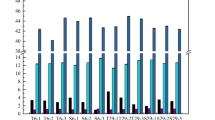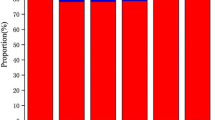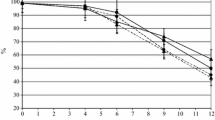Abstract
Non-Saccharomyces cerevisiae can effectively improve the wine quality by co-fermentation with Saccharomyces cerevisiae. In this study, the effects of Pichia kluyveri DG2 on the flavor characteristics of wine when co-culturing with S. cerevisiae MT were systematically researched. Compared to the fermentation by S. cerevisiae alone, P. kluyveri slowed down the fermentation process slightly but increased the productions of glycerol and esters (8.5% and 142%). Additionally, yield of total higher alcohols reduced in the co-fermentation. The sensory characteristics of the wine obtained by co-fermentation were improved obviously. Transcriptome analysis further showed that 512 genes were differentially expressed in S. cerevisiae in the co-fermentation, of which 318 genes were up-regulated including genes participating in the biosynthesis of flavor compounds in wine and 194 genes were down-regulated including the ones involved in glycolytic and amino acid metabolic pathways. These results indicated that P. kluyveri was a very promising non-S. cerevisiae for co-fermentation to regulate flavor and improve quality of wine.





Similar content being viewed by others
Data availability
All data are incorporated into online the article and its online supplementary material.
References
Villamor RR, Ross CF (2013) Wine matrix compounds affect perception of wine aromas. Annu Rev Food Sci Technol 4(1):1–20
Zhang BB, Taong T, Yang DQ, Liu H, Xue J, Duan CQ, Yan GL (2022) Effects of three indigenous non-Saccharomyces yeasts and their pairwise combinations in co-fermentation with Saccharomyces cerevisiae on volatile compounds of Petit Manseng wines - sciencedirect. Food Chem 368:130807
Ge Q, Guo C, Yan Y, Sun X, Ma T, Zhang J, Li CH, Gou CL, Yue TL, Yuan Y (2022) Contribution of non- Saccharomyces yeasts to aroma-active compound production, phenolic composition and sensory profile in chinese vidal icewine. Food Biosci 46:101152
Vejarano R, Gil-Calderón A (2021) Commercially available non-Saccharomyces yeasts for winemaking: current market, advantages over Saccharomyces, biocompatibility, and safety. Fermentation 7(3):171
José MM-R, Belén P, Emma C-V, María JJ-H, María C, Carlos G, María JR-M, José MM-R (2021) Impact of sequential inoculation with the non-Saccharomyces T. delbrueckii and M. pulcherrima combined with Saccharomyces cerevisiae strains on chemicals and sensory profile of Rosé wines. J Agric Food Chem 69(5):1598–1609
Wang J, Yan JJ, Zhang WJ, Zhang YX, Dong ZG, Luo H, Liu M, Su J (2023) Comparison of potential Wickerhamomyces anomalus to improve the quality of Cabernet Sauvignon wines by mixed fermentation with Saccharomyces cerevisiae. LWT- Food Sci Technol 173:114285
Ophélie D, Santiago B, Stefanie F, Beata B, Claus-Dieter P, Doris R (2019) Effect of sequential inoculation with non-Saccharomyces and Saccharomyces yeasts on riesling wine chemical composition. Fermentation 5(3):79
Liu YJ, Lu YY, Liu SQ (2021) The potential of spent coffee grounds hydrolysates fermented with Torulaspora delbrueckii and Pichia kluyveri for developing an alcoholic beverage: The yeasts growth and chemical compounds modulation by yeast extracts - sciencedirect. Curr Res Food Sci 4:489–498
Helena R-M, Ester D-Y, Albert M, María-Jesús T, Gemma B (2022) Importance of micronutrients and organic nitrogen in fermentations with Torulaspora delbrueckii and Saccharomyces cerevisiae. Int J Food Microbiol 381:109915
Mencher A, Morales P, Curiel JA, Gonzalez R, Tronchoni J (2021) Metschnikowia pulcherrima represses aerobic respiration in Saccharomyces cerevisiae suggesting a direct response to co-cultivation. Food Microbiol 94:103670
Ruiz J, Celis MD, Toro MD, Mendes-Ferreira A, Belda I (2020) Phenotypic and transcriptional analysis of Saccharomyces cerevisiae during wine fermentation in response to nitrogen nutrition and co-inoculation with Torulaspora delbrueckii. Food Res Int 137:109663
Zhang W, Weng P, Wu Z (2020) Interaction profile of a mixed-culture fermentation of Issatchenkia orientalis and Saccharomyces cerevisiae by transcriptome sequencing. Brit Food J. https://doi.org/10.1108/BFJ-06-2020-0510
Kong CL, Ma N, Yin J, Zhao HY, Tao YS (2021) Fine tuning of medium chain fatty acids levels increases fruity ester production during alcoholic fermentation. Food Chem 346:128897
Luan Y, Zhang BQ, Duan CQ, Yan GL (2018) Effects of different pre-fermentation cold maceration time on aroma compounds of Saccharomyces cerevisiae co-fermentation with Hanseniaspora opuntiae or Pichia kudriavzevii. LWT- Food Sci Technol 92:177–186
Liu SX, Laaksonen O, Kortesniemi M, Kalpio M, Yang B (2018) Chemical composition of bilberry wine fermented with non- Saccharomyces yeasts (Torulaspora delbrueckii and Schizosaccharomyces pombe) and Saccharomyces cerevisiae in pure, sequential and mixed fermentations. Food Chem 266:262–274
Han X, Xin Q, Yang S, Li R, Huang W (2021) Study on the diversity of non-saccharomyces yeasts in chinese wine regions and their potential in improving wine aroma by β-glucosidase activity analyses. Food Chem 360:129886
Lage P, Barbosa C, Mateus B, Vasconcelos I, Mendes-Faiaa A, Mendes-Ferreiraa A (2014) H. guilliermondii impacts growth kinetics and metabolic activity of S. cerevisiae: the role of initial nitrogen concentration. Int J Food Microbiol 172:62–69
Mhl A, Pkbb C, Mew A, Kmsa C, Prga C, Vja C (2020) Evaluation of indigenous non-Saccharomyces yeasts isolated from a South Australian vineyard for their potential as wine starter cultures. Int J Food Microbiol 312:108373
Jiang X, Lu Y, Liu SQ (2020) Effects of different yeasts on physicochemical and oenological properties of red dragon fruit wine fermented with Saccharomyces cerevisiae, Torulaspora delbrueckii and Lachancea thermotolerans. Microorganisms 8(3):315
González-Royo E, Pascual O, Kontoudakis N, Esteruelas M, Esteve-Zarzoso B, Mas A, Canals JM, Zamora F (2015) Oenological consequences of sequential inoculation with non-Saccharomyces yeasts (Torulaspora delbrueckii or Metschnikowia pulcherrima) and Saccharomyces cerevisiae in base wine for sparkling wine production. Eur Food Res Technol 240:999–1012
Contreras A, Hidalgo C, Henschke PA, Chambers PJ, Varela C (2014) Evaluation of non-Saccharomyces yeasts for the reduction of alcohol content in wine. Appl Environ Microb 80(5):1670–1678
Varela C, Barker A, Tran T, Borneman A, Curtin C (2017) Sensory profile and volatile aroma composition of reduced alcohol merlot wines fermented with Metschnikowia pulcherrima and Saccharomyces uvarum. Int J Food Microbiol 252:1–9
Dzialo MC, Park R, Steensels J, Lievens B, Verstrepen KJ (2017) Physiology, ecology and industrial applications of aroma formation in yeast. FEMS Microbiol Rev 41:S95–S128
Wang YP, Wei XQ, Guo XW, Xiao DG (2020) Effect of the deletion of genes related to amino acid metabolism on the production of higher alcohols by Saccharomyces cerevisiae. BioMed Res Int. https://doi.org/10.1155/2020/6802512
Camelweyre M, Lytra G, Tempere S, Barbe JC (2015) Olfactory impact of higher alcohols on red wine fruity ester aroma expression in model solution. J Agric Food Chem 63(44):9777–9788
Camelweyre M, Lytra G, Tempere S, Barbe JC (2018) Static headspace analysis using low-pressure gas chromatography and mass spectrometry, application to determining multiple partition coefficients: a practical tool for understanding red wine fruity volatile perception and the sensory impact of higher alcohols. Anal Chem 90(18):10812–10818
Ge Q, Guo C, Zhang J, Yan Y, Yuan Y (2021) Effects of simultaneous co-fermentation of five indigenous non-Saccharomyces strains with S. cerevisiae on vidal icewine aroma quality. Foods 10(7):1452
Tronchoni J, Curiel JA, Morales P, Torres-Pérez R, Gonzalez R (2017) Early transcriptional response to biotic stress in mixed starter fermentations involving Saccharomyces cerevisiae and Torulaspora delbrueckii. Int J Food Microbiol 241:60–68
Shekhawat K, Patterton H, Bauer FF, Setati ME (2019) RNA-seq based transcriptional analysis of Saccharomyces cerevisiae and Lachancea thermotolerans in mixed-culture fermentations under anaerobic conditions. BMC Genomics 20(1):145
De Smidt O, Du Preez JC, Albertyn J (2012) Molecular and physiological aspects of alcohol dehydrogenases in the ethanol metabolism of Saccharomyces cerevisiae. FEMS Yeast Res 12(1):33–47
Mohand S, Sandrine R, Vanessa D, Herve A, Tourdot-Marechal R (2017) Metschnikowia pulcherrima influences the expression of genes involved in PDH bypass and glyceropyruvic fermentation in Saccharomyces cerevisiae. Front Microbiol 8:1137
Park SH, Kim S, Hahn JS (2014) Metabolic engineering of Saccharomyces cerevisiae for the production of isobutanol and 3-methyl-1-butanol. Appl Microbiol Biot 98(21):9139–9147
Wang YP, Sun ZG, Wei XQ, Guo XW, Xiao DG (2021) Identification of core regulatory genes and metabolic pathways for the n-propanol synthesis in Saccharomyces cerevisiae. J Agric Food Chem 69:1637–1646
Berg MA, Steensma HY (2010) ACS2, a Saccharomyces cerevisiae gene encoding acetyl-coenzyme A synthetase, essential for growth on glucose. FEBS J 231(3):704–713
Ding J, Holzwarth G, Penner MH, Patton-Vogt J, Bakalinsky AT (2015) Overexpression of acetyl-CoA synthetase in Saccharomyces cerevisiae increases acetic acid tolerance. FEMS Microbiol Lett 362(3):1–7
He QN, Yang YF, Yang SH, Donohoe BS, Van Wychen S, Zhang M (2018) Oleaginicity of the yeast strain Saccharomyces cerevisiae D5A. Biotechnol Biofuels 11(1):258
Zhang YJ, Ning FK, Li X, Ten MK (2013) Structural insights into cofactor recognition of yeast mitochondria 3-oxoacyl-ACP reductase OAR1. IUBMB Life 65(2):154–162
Leber C, Jin WC, Polson B, Silva N (2016) Disrupted short chain specific β-oxidation and improved synthase expression increase synthesis of short chain fatty acids in Saccharomyces cerevisiae. Biotechnol Bioeng 113(4):895–900
Delgado ML, O’Connor JE, Azorın I, Renau-Piqueras J, Gil ML, Gozalbo D (2001) The glyceraldehyde-3-phosphate dehydrogenase polypeptides encoded by the Saccharomyces cerevisiae TDH1, TDH2 and TDH3 genesare also cell wall proteins. Microbiology 147:411–417
Francisca R-G, Isabel ES-A, Estruch F, Prieto JA (2020) The formation of hybrid complexes between isoenzymes of glyceraldehyde-3-phosphate dehydrogenase regulates its aggregation state, the glycolytic activity and sphingolipid status in Saccharomyces cerevisiae. Microb Biotechnol 13(2):562–571
Taylor BV, Mcneil JB, Mcintosh EM, Zhang FR, Bognar AL (1993) Cloning of the genes encoding the serine hydroxymethyltransferases from Saccharomyces cerevisiae. Adv Exp Med Biol 338:711–714
Boredi SC, Debra R, Florian FB (2015) Identifying and assessing the impact of wine acid-related genes in yeast. Curr Genet 62(1):149–164
Acknowledgements
This work was supported by Key R&D Program of Ningxia Hui Autonomous Region, No.2020BFH02006.
Author information
Authors and Affiliations
Contributions
We declare that the manuscript entitled “Effects of Pichia kluyveri on the flavor characteristics of wine by co-fermentation with Saccharomyces cerevisiae” is our collaborated work. Manman Gao, Lijuan Ma, Ziping Du and Liping Du conceived and designed the experiments; Manman Gao, Jiangnan Hu, Xuejiao Wang and Heyun Zhang performed the experiments; Manman Gao, Lijuan Ma, Ziping Du and Liping Du analyzed the data and prepared manuscript; Liping Du, Huiling Zhang, Xiaoju Tian and Weiming Yang reviewed the paper.
Corresponding authors
Ethics declarations
Conflict of interest
The authors declare that they have no known competing financial interests or personal relationships that could have appeared to influence the work reported in this paper.
Ethical statement
I certify that this manuscript is original and has not been published and will not be submitted elsewhere for publication while being considered by European Food Research and Technology. And the study is not split up into several parts to increase the quantity of submissions and submitted to various journals or to one journal over time. This article does not contain any studies with human participants or animals performed by any of the authors.
Additional information
Publisher's Note
Springer Nature remains neutral with regard to jurisdictional claims in published maps and institutional affiliations.
Supplementary Information
Below is the link to the electronic supplementary material.
Rights and permissions
Springer Nature or its licensor (e.g. a society or other partner) holds exclusive rights to this article under a publishing agreement with the author(s) or other rightsholder(s); author self-archiving of the accepted manuscript version of this article is solely governed by the terms of such publishing agreement and applicable law.
About this article
Cite this article
Gao, M., Hu, J., Wang, X. et al. Effects of Pichia kluyveri on the flavor characteristics of wine by co-fermentation with Saccharomyces cerevisiae. Eur Food Res Technol 249, 1449–1460 (2023). https://doi.org/10.1007/s00217-023-04224-x
Received:
Revised:
Accepted:
Published:
Issue Date:
DOI: https://doi.org/10.1007/s00217-023-04224-x




